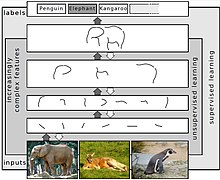Machine Learning
It involves using algorithms that use statistics to find patterns in very large amounts of data (numbers, words, images, clicks, etc). The algorithm essentially looks for a pattern from a data set, then applies that pattern to a new data set. Machine Learning has 3 main learning methods: Supervised learning - a labelled data set is used to train the algorithm with what pattern it should look for. Unsupervised learning - an unlabelled (and unsupervised) data set Is analysed for patterns to train the algorithm. Reinforcement learning - It learns by trial and error to train the algorithm. [112]
Deep learning

Deep learning[110] uses several layers of neurons between the network's inputs and outputs. The multiple layers can progressively extract higher-level features from the raw input. For example, in image processing, lower layers may identify edges, while higher layers may identify the concepts relevant to a human such as digits or letters or faces.[114]
Deep learning has drastically improved the performance of programs in many important subfields of artificial intelligence, including computer vision, speech recognition, natural language processing, image classification[115] and others. The reason that deep learning performs so well in so many applications is not known as of 2023.[116] The sudden success of deep learning in 2012–2015 did not occur because of some new discovery or theoretical breakthrough (deep neural networks and backpropagation had been described by many people, as far back as the 1950s)[j] but because of two factors: the incredible increase in computer power (including the hundred-fold increase in speed by switching to GPUs) and the availability of vast amounts of training data, especially the giant curated datasets used for benchmark testing, such as ImageNet.[k]
Specialized hardware and software
In the late 2010s, graphics processing units (GPUs) that were increasingly designed with AI-specific enhancements and used with specialized TensorFlow software, had replaced previously used central processing unit (CPUs) as the dominant means for large-scale (commercial and academic) machine learning models' training.[125] Historically, specialized languages, such as Lisp, Prolog, Python and others, had been used.
Applications
AI and machine learning technology is used in most of the essential applications of the 2020s, including: search engines (such as Google Search), targeting online advertisements, recommendation systems (offered by Netflix, YouTube or Amazon), driving internet traffic, targeted advertising (AdSense, Facebook), virtual assistants (such as Siri or Alexa), autonomous vehicles (including drones, ADAS and self-driving cars), automatic language translation (Microsoft Translator, Google Translate), facial recognition (Apple's Face ID or Microsoft's DeepFace and Google's FaceNet) and image labeling (used by Facebook, Apple's iPhoto and TikTok).



No comments:
Post a Comment